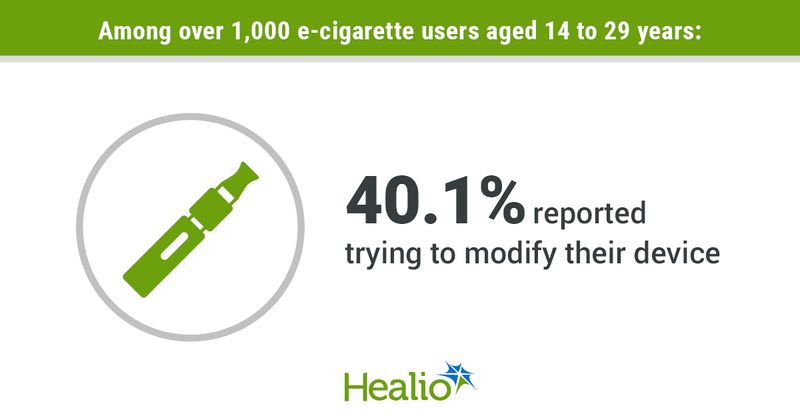Many young e-cigarette users report trying to ‘hack’ devices
Key takeaways:
- Overall, 35.8% of survey respondents reported recharging the battery of disposable pods.
- Common sources of information on how to modify an e-cigarette were friends and social media.
Approximately 40% of young e-cigarette users reported trying to modify their devices, including by refilling or recharging disposable pods, according to survey results published in Pediatrics.
Research has demonstrated that restrictions placed by the FDA on e-cigarette flavors and products have not dissuaded young consumers from using e-cigarettes, with sales surging to over 22 million units per month in 2022.

The internet and social media platforms provide videos and other types of “how-to” guides that show people how to “hack” e-cigarettes — modifying or changing them in ways they are not designed to be used, according to Grace Kong, PhD, Rachel R. Ouellette, PhD and Meghan E. Morean, PhD, all of the department of psychiatry at Yale School of Medicine.
Kong, Ouellette and Morean authored the new study, along with Yale colleague Juhan Lee, PhD.
“Some examples of hacking include recharging the batteries of e-cigarettes that are not supposed to be recharged, refilling disposable e-cigarettes that are sealed and not intended to be refilled, and adding marijuana to e-cigarettes that are supposed to be used with nicotine,” the three authors told Healio in joint email responses.
“Little is known about what ways and how often adolescents are hacking their e-cigarettes, as well as where they may be learning this information, so we conducted a survey to find out,” they said.
From November 2022 to February 2023, the authors surveyed 1,018 adolescents and adults aged 14 to 29 years in the United States who reported using e-cigarettes in the past month. They asked respondents if they were aware of e-cigarette hacks, where they learned about them, and if they had made modifications to their e-cigarettes. Among the hacks they were polled about were:
- refilling rechargeable cartridges or pods;
- refilling disposable pods;
- rewicking or recharging disposable pods;
- modifying nicotine e-liquids;
- combining nicotine and cannabis for simultaneous vaping; and
- putting cannabis into an e-cigarette designed for nicotine vaping.
According to survey responses, 69% had heard about refilling devices not intended to be refilled and 40.1% of participants had tried it. Additionally, 66.4% had heard they could recharge the battery of disposable pods, and 35.8% tried it. The most common sources of information on how to modify an e-cigarette were friends (64.4%) and social media (46.7%).
The researchers also found that people aged younger than 21 years — the legal age to buy tobacco products in the U.S. — were more likely than older individuals to report refilling rechargeable pods or cartridges (P = .03), refilling disposable pod devices (P = .04) and recharging disposable pod devices (P < .01) — an indication that underage individuals may be exposed to more health risks by using e-cigarettes in ways that they are not designed to be used.
Many participants also reported vaping both marijuana and nicotine, which the authors said was expected based on previous studies.
“About half of our participants were aware of hacking e-cigarettes by combining nicotine and marijuana in the same e-cigarette, and 20% reported actually doing this,” they said. “This suggests that vaping devices intended for nicotine and marijuana use can be used interchangeably, potentially putting young people at risk for exposure to both substances.”
Kong, Ouellette and Morean said future studies should continue to track and evaluate the health consequences of modifying e-cigarettes, including lung damage, addiction, burns and nicotine poisoning.
“E-cigarette products are diverse and can be used in different ways — in ways that are both intended and unintended by the manufacturers,” they said. “Primary care providers and pediatricians should ask adolescents and young adults about what substances they are vaping, what types of e-cigarettes they are using — for example: disposable, rechargeable, not refillable, refillable — and whether and how they are hacking their e-cigarettes to better understand potential health risks.”
